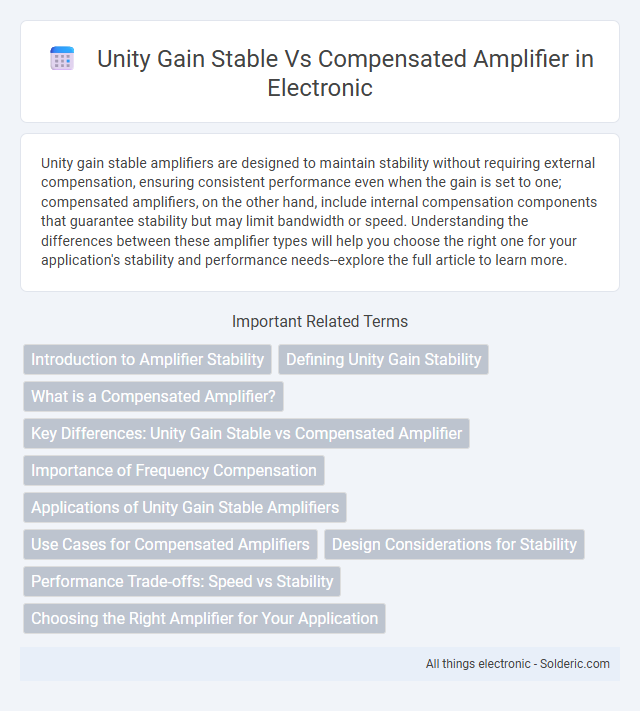Unity gain stable amplifiers are designed to maintain stability without requiring external compensation, ensuring consistent performance even when the gain is set to one; compensated amplifiers, on the other hand, include internal compensation components that guarantee stability but may limit bandwidth or speed. Understanding the differences between these amplifier types will help you choose the right one for your application's stability and performance needs--explore the full article to learn more.
Comparison Table
| Feature | Unity Gain Stable Amplifier | Compensated Amplifier |
|---|---|---|
| Stability | Stable at unity gain (gain = 1) | Stable only with external compensation |
| Design Complexity | Simpler design, internally compensated | Requires external compensation networks |
| Bandwidth | Lower bandwidth due to internal compensation | Higher bandwidth achievable |
| Phase Margin | Typically > 45deg at unity gain | Depends on compensation method used |
| Application | General-purpose, unity gain buffers | High-speed, high-gain amplifiers |
| Gain Flexibility | Limited to unity or higher gains | Supports a wide range of gains |
Introduction to Amplifier Stability
Unity gain stable amplifiers maintain stability without requiring external compensation, ensuring consistent performance across all gain configurations. Compensated amplifiers rely on internal or external compensation networks to prevent oscillations, often trading off bandwidth and slew rate. Stability in amplifiers directly impacts signal integrity, making it a critical factor in high-frequency and precision applications.
Defining Unity Gain Stability
Unity gain stability refers to an amplifier's ability to maintain stable operation when configured with a gain of one, ensuring no oscillations or signal distortions occur. A unity gain stable amplifier is designed with internal frequency compensation, allowing it to operate reliably in buffer or voltage follower configurations without external stabilization components. Understanding unity gain stability is crucial for Your applications requiring precise signal buffering and minimal phase shift.
What is a Compensated Amplifier?
A compensated amplifier incorporates frequency compensation techniques to ensure stability across its entire operating range, preventing oscillations and maintaining consistent gain. It achieves this by integrating components like capacitors or resistors that modify the amplifier's frequency response to avoid unwanted phase shifts. Understanding a compensated amplifier helps you design circuits that reliably perform at unity gain without compromising stability.
Key Differences: Unity Gain Stable vs Compensated Amplifier
Unity gain stable amplifiers maintain stability when operating at a gain of one, making them ideal for buffer or follower configurations without oscillations. Compensated amplifiers incorporate frequency compensation techniques to ensure stability over higher gain settings but may become unstable at unity gain. The key difference lies in their frequency response design: unity gain stable amplifiers have internal compensation for stability at all gains, while compensated amplifiers require external compensation or higher gain to prevent oscillations.
Importance of Frequency Compensation
Frequency compensation is crucial in amplifiers to ensure stability, especially for unity gain configurations where the feedback loop can introduce phase shifts leading to oscillations. A unity gain stable amplifier is designed with internal compensation, allowing it to maintain stable operation without external components across a wide range of frequencies. Compensated amplifiers require external frequency compensation components, enabling designers to tailor the stability and bandwidth according to specific application needs.
Applications of Unity Gain Stable Amplifiers
Unity gain stable amplifiers are essential in buffer and voltage follower circuits where signal integrity and phase stability are critical for driving capacitive loads without oscillation. These amplifiers are widely used in sensor signal conditioning, data acquisition systems, and active filters due to their ability to maintain stability at a gain of one. Their design ensures consistent performance in applications requiring precise impedance matching and low distortion.
Use Cases for Compensated Amplifiers
Compensated amplifiers are ideal for applications requiring stable performance across a broad frequency range, such as precision signal processing and sensor interfacing. Their internal compensation ensures minimal oscillation and consistent gain, making them suitable for high-speed data acquisition and communication systems. You benefit from reliable operation in environments where uncompensated designs could introduce instability and noise.
Design Considerations for Stability
Design considerations for stability in unity gain stable amplifiers emphasize internal compensation techniques that prevent oscillations across all closed-loop configurations, ensuring consistent phase margin and gain bandwidth product. Compensated amplifiers typically incorporate dominant pole compensation, such as Miller capacitors, to shift pole frequencies and maintain stability in higher gain scenarios. Trade-offs between bandwidth, slew rate, and phase margin guide the selection of compensation methods to optimize performance without sacrificing amplifier stability.
Performance Trade-offs: Speed vs Stability
Unity gain stable amplifiers prioritize stability across all gain configurations, ensuring reliable operation without oscillations, but this stability often limits their speed and bandwidth. Compensated amplifiers, optimized for specific gain settings, achieve higher speed and enhanced frequency response at the expense of reduced stability outside those conditions. Understanding these performance trade-offs helps you select an amplifier that balances speed and stability according to your application's requirements.
Choosing the Right Amplifier for Your Application
Unity gain stable amplifiers ensure reliable operation at a gain of one, making them ideal for buffer stages and voltage followers where signal integrity is critical. Compensated amplifiers, designed with internal compensation, provide stable performance across various gain settings but may trade off in bandwidth or slew rate. Your choice depends on the specific application's stability requirements and performance priorities, with unity gain stable models offering simplicity and compensated amplifiers delivering versatility.
unity gain stable vs compensated amplifier Infographic

 solderic.com
solderic.com